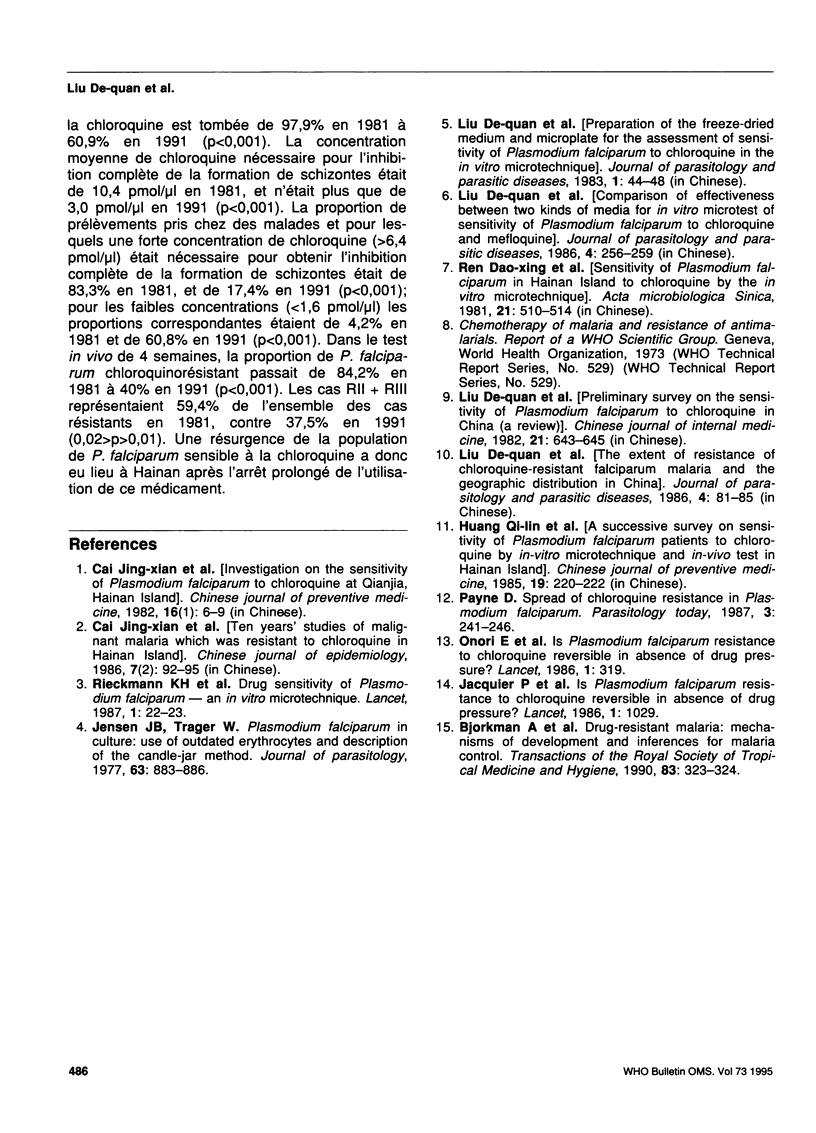Abstract
In 1979, in view of the widespread resistance of Plasmodium falciparum to chloroquine in the island of Hainan, China, it use as an antimalarial was suspended throughout the island. A longitudinal survey of the chloroquine-sensitivity of P. falciparum was carried out over the period 1981-91 to investigate whether its resistance had changed from the 1979 level. In-vitro assays were carried out every 2-3 years, while in-vivo tests were performed annually over the period 1981-83 and also in 1991. Resistance to chloroquine declined progressively after its use had stopped. The in-vitro tests indicated that the rate of chloroquine-resistant P. falciparum was 97.9% in 1981, but dropped to 60.9% in 1991 (P < 0.001). The mean concentration of chloroquine for complete inhibition of schizont formation was 10.4 pmol/microliters in 1981, but decreased to 3.0 pmol/microliters in 1991 (P < 0.001). The proportion of samples taken from malaria cases that required high concentrations ( > 6.4 pmol/microliters) of chloroquine for complete inhibition of schizont formation was 83.3% in 1981, but only 17.4% in 1991 (P < 0.001); at low concentrations ( > 1.6 pmol/microliters), the corresponding proportions increased from 4.2% in 1981 to 60.8% in 1991 (P < 0.001). In the 4-week in-vivo test, the rate of chloroquine-resistant P. falciparum decreased from 84.2% in 1981 to 40% in 1991 (P < 0.001). RII + RIII cases represented 59.4% of the total resistant cases in 1981, but decreased to 37.5% in 1991 (0.02 > P > 0.01).
Full text
PDF



Selected References
These references are in PubMed. This may not be the complete list of references from this article.
- Björkman A., Phillips-Howard P. A. Drug-resistant malaria: mechanisms of development and inferences for malaria control. Trans R Soc Trop Med Hyg. 1990 May-Jun;84(3):323–324. doi: 10.1016/0035-9203(90)90302-u. [DOI] [PubMed] [Google Scholar]
- Huang Q. L. [A successive survey on the sensitivity of P. falciparum patients to chloroquine by in vitro microtechnic and in vivo test on Hainan Island]. Zhonghua Yu Fang Yi Xue Za Zhi. 1985 Jul;19(4):220–222. [PubMed] [Google Scholar]
- Jensen J. B., Trager W. Plasmodium falciparum in culture: use of outdated erthrocytes and description of the candle jar method. J Parasitol. 1977 Oct;63(5):883–886. [PubMed] [Google Scholar]
- Payne D. Spread of chloroquine resistance in Plasmodium falciparum. Parasitol Today. 1987 Aug;3(8):241–246. doi: 10.1016/0169-4758(87)90147-5. [DOI] [PubMed] [Google Scholar]
- Rieckmann K. H., Campbell G. H., Sax L. J., Mrema J. E. Drug sensitivity of plasmodium falciparum. An in-vitro microtechnique. Lancet. 1978 Jan 7;1(8054):22–23. doi: 10.1016/s0140-6736(78)90365-3. [DOI] [PubMed] [Google Scholar]


